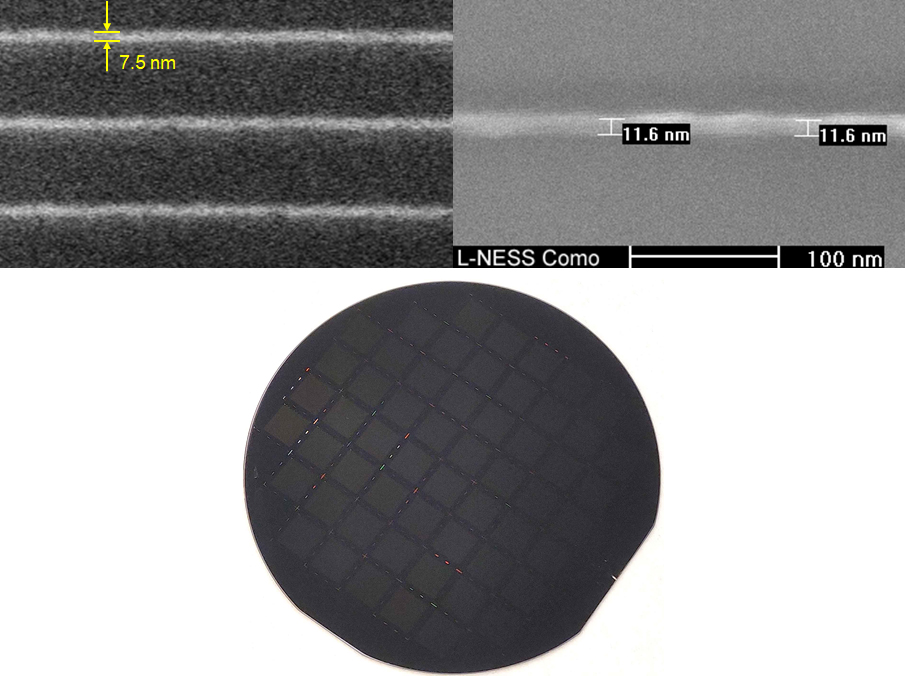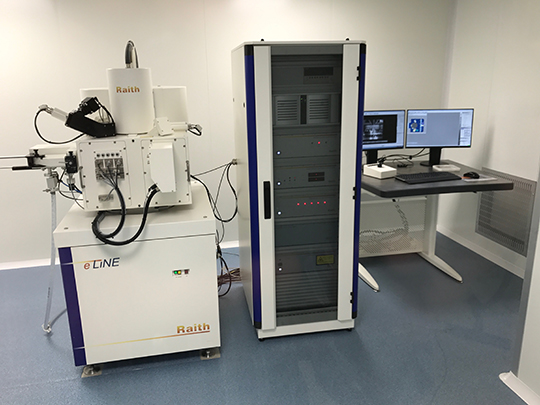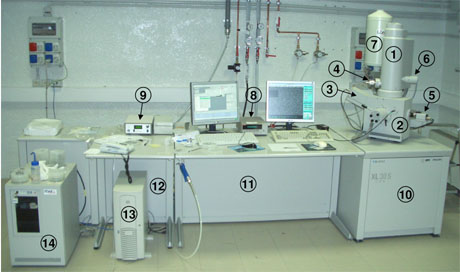Electron beam lithography
The ever-growing demand for increasing the integration scale of digital electronics has prompted a search for novel devices and fabrication techniques at the nanometer scale. State of the art ArF deep ultra violet (DUV) lithography is able to deliver transistors with the gate pitch as small as 54 nm at the 10 nm node (Intel, 2017). Electron beam lithography (EBL) is an indispensable technique for making the nanoelectronic devices on an even smaller scale (Fig. 1).

Fig. 1. The narrowest lines that can be patterned by our EBL systems on a standard SiO2/Si substrate. (left) ~ 7 nm wide lines patterned by our Raith eLINE system in HSQ resist. (right) ~ 11 nm wide metallic line patterned by our old e-beam system in 200 nm thick PMMA resist. The line consists of 3 nm of chromium and 10 nm of gold. The scale bar is the same in both images.
In this technique, a highly focused electron beam is scanned over a surface covered by a resist sensitive to electron radiation (e.g., polymethyl-methacrylate - PMMA). Exposed areas become more (positive resist) or less (negative resist) soluble in organic solvents (e.g., methyl isobutyl ketone - MIBK), which are used to develop the exposed pattern. The pattern is transferred to the substrate by etching (e.g., reactive ion etching) or lift-off (e.g., metallization).
While the resolution of DUV lithography is mostly limited by the wavelength of the ArF excimer laser, diffraction is not the limiting factor in EBL due to a very small electron wavelength (less than 0.01 nm at 20 keV). The resolution of EBL is mostly limited by imperfections in the electron optics (aberrations limit the minimum electron beam spot size to ~ 1 nm) and electron scattering in resist and backscattering from the substrate. These effects limit the smallest feature size to ~ 10 nm after lift-off.
EBL is not suitable for a large scale production because electron beam exposure is a serial process (i.e., it is much slower than DUV lithography). On the other hand, EBL is a fabrication tool of choice in nanoelectronics and low-dimensional physics. It allows researchers to fabricate and investigate very small devices which might be used in the future. The main advantage of EBL in research setting is its direct write capability, i.e., no need for making a mask as required by a DUV lithography. EBL is used industrially in mask making for DUV lithography.
The work on EBL in Como started in May 2005 with the installation of a scanning electron microscope (SEM) with a lithography attachment. The group is currently equipped with two EBL systems:
- Raith eLINE (shown in Fig. 2) is a fully integrated EBL system. The main features are: Schottky field-emission gun, acceleration voltage up to 30 kV, high-speed pattern generator (20 MHz), laser interferometer stage with a stitching error < 20 nm and 100 x 100 mm horizontal and 30 mm vertical travel range under full interferometric control, alignment error < 20 nm, automated laser height sensing (working distance error < 5 µm), traxx module for stitching error free continuous writing mode for elongated paths (fixed-beam moving stage mode - FBMS), 3D module, and manual load-lock.
- Philips XL30 SFEG SEM with a Raith Elphy Quantum lithography attachment (6 MHz pattern generator) and a Scanservice beam blanker. This is our original EBL system (shown in Fig. 3) which is mainly used as a backup.

Fig. 2. Our new Raith eLINE system. The EBL resolution limit is ~ 7 nm, corresponding to the width of the lines patterned in a thin HSQ resist at 30 kV.

Fig. 3. Our old EBL system. Parts: 1. Column 2. Specimen chamber 3. Secondary electron detector 4. Scanservice final aperture with integrated beam blanker 5. CCD camera 6. High tension valve 7. Liquid N2 tank (for X-ray detector) 8. Keithley pico-ammeter (to measure beam current) 9. Beam blanker power supply 10. Vacuum pumps and high tension circuitry 11. Electronics (printed circuits boards) 12. Power supply 13. Lithography PC (Raith Elphy Quantum) 14. SEM PC with integrated X-ray analyzer.
Copyright © 2010 L-NESS Como
